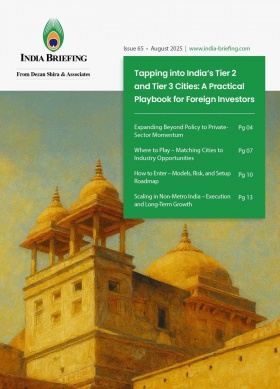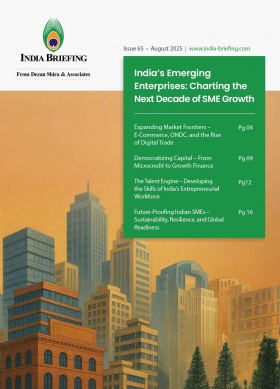Why Foreign Companies Fail in India: 5 Costly Mistakes and Lessons for Future Investors
Foreign companies often fail in India due to five recurring mistakes: choosing the wrong entry structure, misjudging regulatory complexity, misreading consumer behavior, adopting poor market models, and weak talent management.
India presents an extraordinary market opportunity that extends far beyond its population scale. With a Gross Domestic Product (GDP) of US$4.4 trillion, India ranks as the world’s fourth-largest economy and is projected to overtake Germany to secure third position by 2027. The Indian economy maintained 6.5 percent GDP growth in FY 2024-25, with Q4 reaching 7.4 percent growth.
Over 65 percent of India’s population is under the age of 35, forming a young, digitally native consumer base with rising aspirations and increasingly experimental consumption patterns.
However, a common misconception persists among foreign businesses: that the country’s large scale automatically translates into business success. In reality, India is not a single, uniform market but a collection of diverse micro-markets – each with its own consumer preferences, cultural nuances, and regulatory requirements.
Between 2014 and 2021, more than 2,783 foreign firms exited India, even though nearly 11,000 new entrants arrived during the same period. As per Federation of Indian Chambers of Commerce & Industry (FICCI) data, over 40 percent of foreign companies fail within five years of market entry. The failures often trace back to compliance disputes, tax liabilities, cultural missteps, or unexpected policy shifts of Indian government.
Market entry mistakes: Lessons from foreign companies that stumbled in India
We look at five cases of how multinational giants stumbled in India in this article and discuss some of the lessons future investors can draw from their experience.
1. Choosing the wrong market entry structure
One of the most frequent mistakes foreign companies make in India is selecting an unsuitable entry vehicle. The choice between setting up a wholly-owned subsidiary, joint venture, branch office, or liaison office shapes how much control a firm has, the ability to scale, and overall operational flexibility.
Liaison offices often create the most difficulties. They can only act as intermediaries and cannot undertake activities of trading or manufacturing. Companies that start with this structure frequently find themselves constrained once the market expands.
A more complex example involves joint ventures.
In 2009, NTT DoCoMo invested in Tata Teleservices with a shareholder agreement that included a downside protection clause. The clause guaranteed DoCoMo either 50 percent of its investment or fair market value upon exit. However, the Reserve Bank of India (RBI) treated assured-return clauses as debt instruments, which are subject to limits on investment in India. Tata therefore required RBI approval to meet the predetermined exit price of INR 58.045 per share, but the approval was denied.
DoCoMo approached the London Court of International Arbitration (LCIA) in January 2015. In June 2016, the tribunal awarded it US$1.17 billion in damages for Tata’s failure to perform its exit obligation. When Tata sought to enforce the award in India, RBI again attempted to intervene. The Delhi High Court ruled that RBI lacked standing under the Arbitration and Conciliation Act, and then, DoCoMo was able to exit with its award.
The DoCoMo-Tata case shows how exit clauses and put options must comply with investment regulations, especially central bank rules governing equity valuation and repatriation. It also illustrates the importance of specialist legal and regulatory consultation, continuous monitoring for policy changes, and proactive contract structuring.
Companies should also incorporate market due diligence and business intelligence into their entry strategy, prepare contingency plans for potential buy-back obligations, and ensure that governance bodies build in periodic review mechanisms. These steps can significantly reduce the risk of disputes escalating into costly and time-consuming litigation.
ALSO READ: Private Limited vs LLP vs OPC in India: Complete Guide for Foreign Investors
2. Misjudging regulatory complexity
Many multinational companies have struggled when they assumed global compliance practices were sufficient to deal with regulations and policies of emerging markets.
Emerging markets, with the carrot of rapid growth, also offer a stick of sudden changes to tax rules and foreign investment caps. Businesses also face multiple approval layers where central and state governments apply conflicting requirements.
For example, India’s customs rules differentiate between Completely Knocked Down (CKD) vehicle kits and individual components. CKD units face duties of 30-35 percent, and separate parts attract duties in the range of 5-15 percent. Missteps in their classification can carry heavy costs, as auto giants Volkswagen and Kia experienced.
Volkswagen has been accused of misclassifying vehicle imports for over a decade. Authorities claim the company imported 90-95 percent of vehicle parts in staggered shipments using proprietary software to split bulk orders into smaller consignments, thereby avoiding higher CKD tariffs. The case has resulted in India’s largest-ever import tax demand of US$1.4 billion. Other automakers, including Mercedes-Benz and BMW, correctly classified similar imports, which means Volkswagen’s approach was an outlier.
Kia faced a similar investigation. Officials allege that over 90 percent of parts for its Carnival MPV were imported as separate shipments, declared as individual components, even though the vehicle was presented as CKD on the company’s own website. A detailed 432-page government notice has supported this demand, which leaves Kia with a potential US$155 million tax liability.
These cases show the importance of strict compliance with local rules and maintaining transparent documents. Firms should ensure they have clear communication channels with customs authorities, study advance rulings on classifications, and keep a risk reserve for retrospective demands that may arise in future.
3. Misreading local consumer behavior and supply chains
Foreign companies often overestimate their pricing, packaging, and product features that succeed in mature economies but may not resonate in markets where affordability and taste drive purchasing decisions. In India, firms with fragmented local supplier networks and weak last-mile logistics face hurdles of higher costs and limited product reach as against businesses that have better market intelligence and local partnerships.
General Motors’ (GM) decision to exit India in 2017, after more than two decades of operations and over US$1 billion in investment, illustrates the risks of not reading the consumer taste right. By 2015, GM held only a 1 percent share, far below market expectations. The company failed to match India’s dominant price band of INR 300,000-600,000 (US$3,403.8-US$6,807.7), where most small cars are sold. Instead, it introduced higher-priced vehicles that did not meet the affordability expectations of Indian households.
GM’s reliance on imports and a weak local supplier base compounded the challenge. Unlike Maruti Suzuki and Hyundai, which localized manufacturing to cut costs, GM struggled with high input prices that made its vehicles uncompetitive. There were frequent leadership changes to deepen its instability. The company appointed nine CEOs in 21 years, averaging just 2.5 years per tenure, compared with market leader Maruti, which had only five CEOs over 35 years.
GM started as a joint venture with Hindustan Motors in 1994, moved to independent operations, entered a 50:50 partnership with SAIC in 2009, and later returned to majority ownership in 2012. This instability, combined with the 2008 global financial crisis and its then ongoing corporate restructuring, also diverted its attention away from India operations.
GM’s failure demonstrates that success in the Indian automotive market requires building deep local supply chain network, prices should be realistic and cater to average customer spending, leadership should be stable and patient, and there should be a willingness or company bandwidth to treat the Indian market as a long-term commitment. In emerging markets, it is better to do a phased expansion, rather than make aggressive early investments, for a more sustainable future.
4. Adopting a wrong market model and challenges with cultural context
Firms can pay a heavy price for choosing the wrong business model, like choosing retail vs online, small retail stores vs large format stores. Cultural blind spots also compound these challenges. Sometimes, marketing campaigns that fail to respect local values risk alienating customers.
Dunkin’ Donuts experienced this with its entry into India in 2012 with a vision of 500 outlets nationwide, through a partnership with Jubilant FoodWorks. By 2018, more than half its stores had closed, making it an example of cultural misfit and adopting the incorrect market model in the fast-moving consumer goods (FMCG) segment.
The brand misread India’s beverage culture, where, as per the industry body, Tea Board of India, tea accounts for 90 percent of hot drink consumption. Donuts never gained traction as a routine snack. Pricing further alienated customers, as donuts sold for INR 60-90 (US$0.6-1), with average spends of INR 150-250[SS1] (US$1.7-2.8), in contrast to much cheaper and widely available local options.
Its real estate and infrastructure strategy only worsened its problem. Dunkin’ operated large-format stores in high-rent metro areas, an approach which could be unsuitable for India’s dense cities and low-margin food service market. Competitors like McDonald’s were building smaller, high-turnover outlets, and Starbucks sustained itself as an aspirational outlet. But Dunkin’ lacked a clear product and brand identity. It offered donuts, burgers, and local snacks in an attempt to appeal broadly but achieving brand confusion instead.
The cultural context also worked against the brand. Indian dessert consumption is a group affair. The traditional sweets are served in portions meant for group sharing. Dunkin’s individual portions clashed with these practices and reduced its products relevance during social occasions or festivals. Moreover, Indians don’t typically view donuts as a breakfast item and prefer savory meals.
Recognizing these challenges, Dunkin’ eventually restructured its strategy. It shifted toward smaller kiosks, introduced tea-based beverages and an expanded drink menu, and realigned its offerings more closely with local preferences – drawing lessons from the successful India strategy of its sister brand, Baskin-Robbins.
The lessons for foreign food service brands is this: success in India requires adapting beyond core offerings. Companies must localize pricing, product formats, consumption experiences, and store strategies to fit the local context. Iconic examples, such as McDonald’s Aloo Tikki Burger, demonstrate how tailoring menus and business models – not merely replicating global playbooks – can unlock sustainable growth in India’s complex consumer market.
5. Weak stakeholder and talent management
Ineffective stakeholder engagement and workforce management can have significant consequences for foreign companies operating in India – ranging from costly disruptions to lasting reputational damage. Several high-profile incidents illustrate how inadequate communication, neglect of labor concerns, and poor human resource strategies can undermine even the most established global brands.
In September 2024, Samsung faced one of the most visible labor disputes in recent years when approximately 1,000 workers at its Tamil Nadu factory went on strike for over a month. The facility accounted for 20-30 percent of Samsung’s US$12 billion annual revenue in India. Workers were demanding wage increases and official recognition of their union, but a lack of communication between management and the workforce prolonged the standoff, highlighting gaps in stakeholder engagement and grievance redressal mechanisms.
Apple’s supply chain partners have also struggled with workforce-related challenges. In 2020, thousands of contract workers at Wistron’s iPhone assembly plant in Karnataka staged a protest over unpaid wages and excessive working hours, resulting in an estimated US$7 million in property damage. In 2021, Foxconn was forced to shut down its facility for over three weeks after hundreds of women workers fell ill due to contaminated food in company-provided hostels. More recently, in February 2024, Flex, another key Apple supplier, faced a strike involving 750 employees demanding higher wages and union recognition.
These incidents demonstrate the importance of proactive labor relations, transparent communication channels, and responsive HR practices. Foreign firms must invest in building trusted dialogue mechanisms, engage regularly with worker representatives, and integrate stakeholder management into their broader risk mitigation strategy. Failure to do so not only disrupts operations but also threatens long-term competitiveness in India’s increasingly strategic manufacturing landscape.
Cultural communication breakdown
Beyond labor unrest, foreign companies often misread workplace culture in India.
Companies that attempt to impose flat hierarchies without adapting to Indian working conditions often encounter resistance. The “yes culture” adds another complexity. Employees may agree to requests or deadlines even when they are impractical and this could lead managers to rely on commitments that cannot be met.
Indian business culture also prioritizes relationships over immediate task completion. Foreign companies focusing only on work deadlines and output, without investing in interpersonal trust, frequently struggle with employee engagement and long-term retention of talent.
Summary
Foreign companies in emerging markets often fail not due to weak products, but because of inadequate preparation. Many undermine their expansion by misunderstanding regulations, misreading consumer behavior, overlooking cultural nuances, or choosing the wrong market entry model. Successful firms invest time in studying local rules, hiring local expertise, and adapting pricing and products to local needs. Without these steps, even well-funded companies risk costly setbacks or premature exits.
(US$1 = INR 88.13)
About Us
India Briefing is one of five regional publications under the Asia Briefing brand. It is supported by Dezan Shira & Associates, a pan-Asia, multi-disciplinary professional services firm that assists foreign investors throughout Asia, including through offices in Delhi, Mumbai, and Bengaluru in India. Dezan Shira & Associates also maintains offices or has alliance partners assisting foreign investors in China, Hong Kong SAR, Vietnam, Indonesia, Singapore, Malaysia, Mongolia, Dubai (UAE), Japan, South Korea, Nepal, The Philippines, Sri Lanka, Thailand, Italy, Germany, Bangladesh, Australia, United States, and United Kingdom and Ireland.
For a complimentary subscription to India Briefing’s content products, please click here. For support with establishing a business in India or for assistance in analyzing and entering markets, please contact the firm at india@dezshira.com or visit our website at www.dezshira.com.
- Previous Article India-EFTA Trade Pact Comes into Effect Oct. 1, 2025
- Next Article What is GST Migration and Why it Matters for Businesses?








